The Podcast Project: Building Listening Skills and Vocabulary through Authentic Media
By Andres Antonio Daniel Labra, Saint Louis University
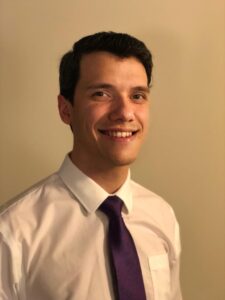
The Podcast Project is a collaborative online resource designed by a team of graduate students and faculty from the Language Resource Center at Saint Louis University. The platform, which uses WordPress and H5P, focuses on two main objectives: the development of listening comprehension and the acquisition of new vocabulary. This Open Educational Resource (OER) offers a series of lessons and exercises based on unaltered target language podcasts in Spanish and French. This kind of learning activity based upon authentic multimedia aims to expose listeners to a wide variety of rich vocabulary as naturally spoken in the language they are learning. By engaging in carefully-designed self-directed lesson plans, learners can boost their listening comprehension independently outside of the formal context of the classroom. Let’s now consider why the Podcast Project can serve as an effective supplemental tool for second language instruction.
First, the project caters to the need for honing listening comprehension. This is undoubtedly an essential skill, yet perhaps the most neglected one in traditional classes. Not only have some teachers confessed to how difficult it is to provide authentic listening resources to build up second language acquisition among students, but SLA experts also recognize the crucial role that this skill should play in today’s classroom in order to facilitate L2 communication: “Most people think that being able to write and speak in a second language means that they know the language, however, if they do not have the efficient listening skills, it is not possible to communicate effectively” (Yildirim et al., 2016, p. 2097).
Additionally, in order to become proficient L2 learners, it is necessary that students independently acquire a large repertoire of vocabulary: “Vimos que el aprendiz de una L2 se enfrenta al reto de tener que saber unas ocho mil palabras […] el alumno mismo tiene que dedicar mucho estudio individual al vocabulario” [We saw that an L2 learner is faced with the challenge of knowing about eight thousand words […] the student has to devote a lot of individual self-study to learn vocabulary] (Blake et al., 2016, p. 66). Other studies have shown that podcasts contribute both to equipping students with the necessary skills to grab meaning through listening as well as building up a good vocabulary repertoire (Rodriguez, 2012 & Hsiao et al. 2012).
In regular classes, however, students’ exposure to the L2 through formal teaching is undoubtedly much more limited than the ideal time suggested by Blake. The curricular and temporal constraints of most classes likely contribute to the challenge of more frequent and more prolonged listening activities in the classroom. Many other factors may contribute to inadequate listening instruction: “the traditional materials for language teaching [are] not efficient enough to teach listening” (Yildirim et al., 2016, p. 2099). Furthermore, listening activities are not as frequently assigned as the other skills, such as writing and reading. In textbooks, authentic listening comprehension is sometimes left aside, and, as a consequence, students can only resort to brief, decontextualized, and highly simplified audio content.
Developing Listening Skills through Authentic Sources
The Podcast Project strives to be a useful resource for students in developing their L2 listening comprehension through authentic conversations and compelling storytelling. This input challenges students because it often includes native-like constructions and rates of speech that are less common in materials targeted at language learners. Yet, the Podcast Project strategically alternates top-down and bottom-up exercises to help learners negotiate the meaning of these difficult segments.
During the listening process, it is also important to keep in mind that there are two possible manners from which the listener can grasp the meaning of the expression: top-down and bottom-up processing. The former involves building upon learners’ background knowledge to assemble meaning, while the latter consists of students’ making use of the L2 language sound system, grammar, and word associations in order to understand the expressions. It has been shown that using both processes might cater to students’ different learning preferences regardless of their listening competence level. Yildirim et al. (2016) claim that “top-down processing is more used by skilled listeners while less-skilled listeners use bottom-up processing” (p. 2098).
To better illustrate the approach used, let us consider the Spanish podcast lesson entitled “La eutanasia de papá” [“Dad’s euthanasia”]. This lesson is divided into a pre-listening section and a post-listening section. Although students are encouraged to listen to the podcast entirely before starting the activities, each lesson begins with a pre-listening multiple-choice exercise in which the listener must match the key words. In this lesson, the words “euthanasia” and “dad” from the title are matched with other concepts and ideas such as “tragedy”, “bad news”, or even “family member” in contrast to opposite ideas such as “good news”, “friend” and “adventure” (See Picture 1 below). In this exercise, students are expected to make predictions based on their background knowledge or personal experience, even when they are not sure about the meaning of some words. In the same lesson part B and in the form of a pre-listening, multiple-choice activity, the learner is asked to associate and group words into the category “sentimientos” [feelings], which not only requires them to use previous knowledge to successfully solve the exercise, but also prepares them to understand the feelings of the podcast interviewee.
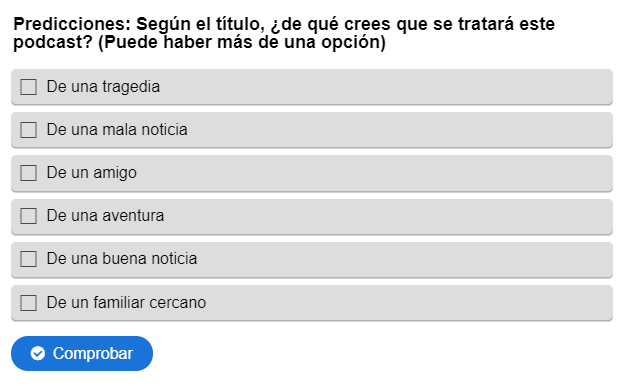
On the other hand, in part C post-listening activity 4 (see Picture 2 below), students are given a sentence with gaps that they must fill in according to the information they listened to. They will need to understand the message in order to successfully complete the exercise since it is not an exact extract from the podcast. However, they might also need to make use of other strategies to resolve it, such as making gender and plurality agreements for word-types, including adjectives, nouns, and verbs. Both the top-down and bottom-up processes are implemented in each lesson, which promote learning success as they offer students exercises which utilize their different listening processes.

Another feature of the Podcast Project is that each lesson centers around authentic media, which brings substantial benefits to L2 learners: “[El podcast auténtico] no solamente sirve como recurso para la comprensión oral del idioma, sino que también puede ser usado para promover el desarrollo de las habilidades de expresión oral” [An authentic podcast not only serves as a resource that leads to oral comprehension, but they can also be used to promote students’ development of speaking skills] (Chacón et al., 2011, p. 44). Podcast channels such as Las Raras, Cosas de Internet, and Nouvelles Écoutes granted authorization for the Podcast Project team to use their podcasts and create lesson plans for open educational purposes. These authentic resources provide listeners opportunities to be exposed to real, unaltered language and speakers’ distinct identities that come from diverse countries such as France, Chile, Argentina, México, Perú, and El Salvador. Each podcast host speaks at a natural flow, with different dialects, and uses a wide range of vocabulary that exceeds the vocabulary terms found in a textbook. As shown in Picture 2 (above), students will learn about “fallecer” [to pass away] as another Spanish variant of the verb “morir” [to die]. Authentic media also teaches figurative expressions, idioms, and even regional slang. In lesson 16 “El viaje de Estrella” [Estrella’s Journey], students focus on the verbal expression “correr peligro” [be in danger], which is related to the concept “morir” [to die]. Additionally, students are immediately provided with feedback that prompts them to use the vocabulary item connected to their own real life experiences (See Picture 3).
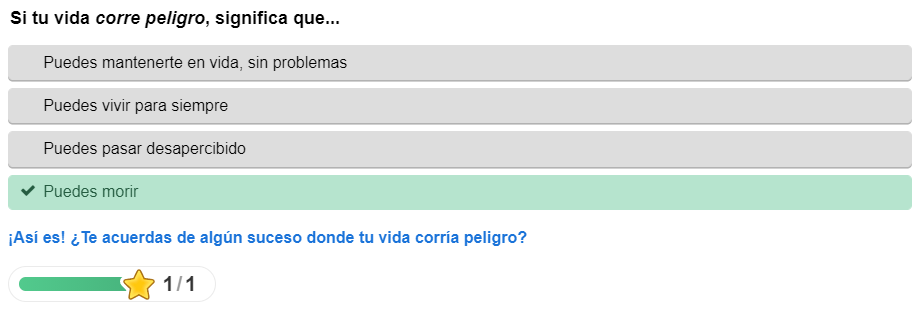
The podcast content is also authentic, as the episodes are based on real life experiences, which gives students the opportunity to reflect and develop intercultural competence. Contextualization complements this project, and it is presented in two forms: vocabulary introduction and contextualized exercises. Thanks to the pre-listening exercises, listeners are prepared from the beginning with the vocabulary they will need to know in order to understand the context of the podcast. Take lesson 6 “Borrar la frontera” [Erasing the border] as an example. The podcast is about a Mexican immigrant who moved to the United States to live there legally, but at one point in time she went back to visit her Mexican neighborhood, only to find out that a wall was being built along the border. The scene left her with strong feelings. The lesson prepares the listeners with a list of “emociones” [feelings] as a before listening exercise, which provides a contextualized framework that will guide them to a better understanding of the vocabulary. Furthermore, the subsequent exercises are presented with contextualized instructions or questions connected to the protagonist or the content of the podcast. By the end of lesson 9, students are expected to create their own response in relation to the podcast by using newly acquired vocabulary.
These contextualized exercises also invite students to interpret the content and use their prior knowledge to select or create their response based on the information they already know or have just learned. Making use of students’ prior knowledge is crucial for listening comprehension and vocabulary acquisition to take place: Nurpahmi (2015) affirms that “the accumulation of schemata contributes most to efficient comprehension and retention of new listening material which are getting more difficult as students progress along the way” (p. 32). Opinion questions at the end of the lesson help activate students’ schemata as they need to combine their own personal experience with the new information learned in the podcast, which at the same time leads to written production. Each lesson part also offers a set of pre-listening exercises that prepares students’ minds for what comes next, facilitating L2 oral and lexical comprehension. In Picture 1 above, questions are designed in the form of prediction/opinion so that students can infer the meaning by connecting the main ideas to known information: cognate euthanasia that students might relate to death should now be associated to other possible ideas such as tragedy or bad news. Thus, students both activate and expand their schemata before listening to the assigned podcast.
Increasing L2 Vocabulary with Podcasts
Contextualization is closely related to the second goal of the platform: vocabulary acquisition. Each lesson plan is constructed and based upon the Structured Input, Structured Output Approach, which consists of manipulating the input in such a way that the target grammatical form can be perceived by the student (Blake et al., 2016, p. 41). Cohen (2008) reminds us that “learners need to meet target vocabulary as many times as possible” (p. 2). Target words and components that appear multiple times throughout the podcast are revisited throughout the lesson and are organized into semantically meaningful chunks.
Take lesson 1 from the Podcast Project as an example. The entire podcast lasts thirty minutes, but in order to target the words that are more frequently repeated throughout the podcast and direct students’ attention to them, the podcast was divided into six fragments, each of them having a series of activities based on the Structured Input Approach. “Eutanasia” [Euthanasia] is one of the target words used in the pre-listening and post-listening activity sections of Lesson 1 part A. The target word that the learner hears in the podcast is used multiple times in the lesson, as a true or false activity, or as part of a list that can be semantically grouped for the listener to match it to a more general category (see Picture 4). For example, learners can group the word Euthanasia as part of the medicine field; or as part of a sequence — sedante comes first, then eutanasia happens.
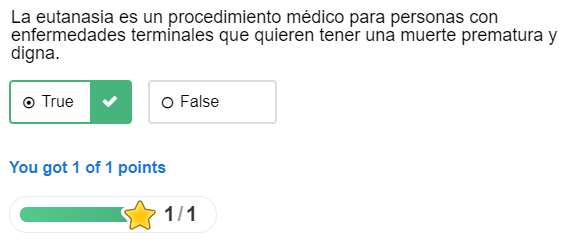
Meaning and contextualization are important considerations under this approach. Dr. Nancy Guilloteau (n.d.) highlights the importance of progressing from decontextualized to contextualized vocabulary. As a whole, each lesson on podcastproject.org is set in one general context or topic. The six fragments corresponding to Lesson 1 revolve around the topics of medicine and euthanasia, and more particularly the experience of a Colombian lawyer struggling to die with dignity. The pre-listening true-false activity shown in Picture 4 above is an example of decontextualized vocabulary from the main topic of the podcast, as it only serves as a comprehension check. There are more contextualized activities in the post-listening section, where a word is used to show form and meaning, while still remaining connected to the main topic. As shown in Picture 2, the verbs enfermar [to get sick], morir [to die], fallecer [to pass away] and the adjective duro [hard] are placed into different word categories– nouns, verb tenses, and adjectives– which students identify in relation to a specific situation of the podcast (Marcela’s mom’s death). Input manipulation can also be found in complete-the-gap exercises, where input is given to students either by hidden hints that prompt them to identify the suitable word by the end of the lesson, or by explicit options and repetitiveness for weaker learners (See Picture 5 below). These exercises are designed to convey meaning through contextualization, namely in relation to a letter from the protagonist of the podcast or from another piece of the interview.
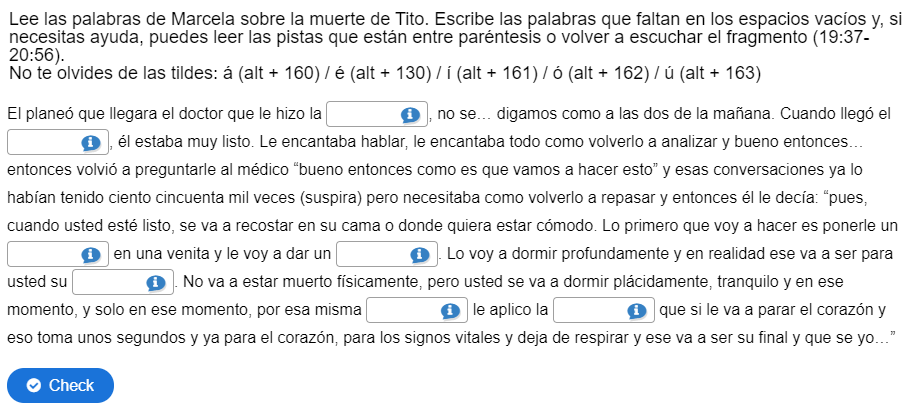
Conclusion
There is no doubt that learning a second language involves more than using a textbook or practicing the language inside the four walls of a classroom for a few hours a week. It definitely requires extra time for the learner to acquire more vocabulary, which can be thought of as the nucleus for communication, and more opportunities to engage in sustained listening comprehension. The Podcast Project aims to be a useful tool for students to sharpen their listening skills while learning a wide variety of words, expressions, and slang terms spoken by native speakers from many countries around the world and for non-pedagogical purposes. The design of lesson plans facilitates comprehension and second-language vocabulary acquisition, as the exercises offer contextualized vocabulary and relevant situational questions. The authors of this project invite all language learners to take advantage of this Open Educational Resource to expand their vocabulary and to boost their listening comprehension skills in Spanish and French.
The author would like to acknowledge the input and support of the following individuals: Dr. Dan Nickolai, Rachel Fox, and Matthew Warner.
References
Blake, R. J., & Zyzik, E. C. (2016). El español y la lingüística aplicada. Washington, DC: Georgetown University Press.
Chacón, C. T., & Pérez, C. J. (2011). El podcast como innovación en la enseñanza del inglés como lengua extranjera. Pixel-Bit. Revista de Medios y Educación, (39), 41-54.
Cohen, J. (2008). Listening to Learn: Boosting Vocabulary with Interactive Activities. Online Submission.
Guilloteau, N. (n.d.). Foreign Language Teaching Methods: Vocabulary. Retrieved February 02, 2021, from https://www.coerll.utexas.edu/methods/modules/vocabulary/
Hsiao, D. L., & VIECO, M. (2012). El podcast bien entendido en curso intensivo es más divertido. marcoELE. Revista de Didáctica Español Lengua Extranjera, (15), 1-12.
Nurpahmi, S. (2015). Improving Listening Skill by Activating Students’ Prior Knowledge. Eternal (English, Teaching, Learning, and Research Journal), 1(1), 28-38.
Rodríguez Rodríguez, M. N. (2012). El podcast: una herramienta didáctica novedosa para E/LE.
Yildirim, S., & Yildirim, Ö. (2016). The importance of listening in language learning and listening comprehension problems experienced by language learners: A literature review. Abant İzzet Baysal Üniversitesi Eğitim Fakültesi Dergisi, 16(4).

